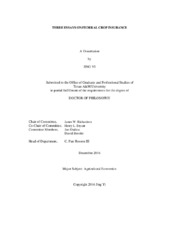| dc.description.abstract | This dissertation evaluates the demand for crop insurance and designs and demonstrates a methodology to estimate the impacts of climate change on the federal crop insurance program (FCIP). An empirical model is built to estimate the demand for corn yield and revenue insurance and wheat yield insurance at each coverage level for the major production regions. Original Least Square regression is used. The results show that the elasticities of demand for federal crop insurance with respect to net premiums are significantly different across crops, coverage levels, insurance plans, and regions. At the 75% coverage level, the elasticity of demand for corn yield and revenue insurance with respect to net premium is -0.654 and -0.670, respectively, in the Southern Plains. The absolute values of the elasticities of demand for corn insurance (0.654 and 0.670) are much higher than the elasticities reported in the majority of the previous studies which do not separate coverage levels and regions in the crop insurance demand analysis. At the 80% coverage level, the elasticity of demand for corn yield insurance with respect to net premium is -0.230, -0.158, and -0.259 in the Corn Belt, Lake States, and Northern Plains, respectively, which are much smaller than the elasticity at the 75% coverage level in the Southern Plains (based on absolute values).
For wheat yield insurance, the elasticity of demand with respect to net premium is -0.264 and -0.145 at the 75% coverage level in the Southern Plains and Northern Plains, respectively. In the Northern Plains, wheat producers would reduce their demand for federal yield insurance by 2.610%, 4.800%, and 7.211% at the 70%, 75%, 80% coverage level, respectively, given a 10 percentage points reduction. Producers in the Southern Plains are expected to reduce their demand for federal wheat yield insurance by 3.153% and 2.636% at the 70% and 75% coverage level, respectively, given a 10 percentage points cut in the subsidy rates.
A methodology is built and demonstrated to evaluate the impacts of climate change on the FCIP for a representative grain sorghum farm. Different user interfaces of the APEX model are use to simulate crop yields for a representative farm. The simulated yields are further used to calculate the representative farm’s insurance premiums, indemnities, and loss ratios. The results indicate that the approved APH yields and federal yield protection insurance premiums would decrease as the grain sorghum yields trend to decrease as climate change continues. Federal crop insurance loss ratios are statistically different in year 2020, 2030, and 2040 for each climate change scenario. Therefore, which climate change scenario is assumed for analyses of the impacts of climate change on the FCIC would result in statistically different conclusions. The study also shows that the efficiency of the current APH formula will not be negated by climate change since no extreme yield change occurs during 2020 – 2040 based on the climate change forecasts. | en |


